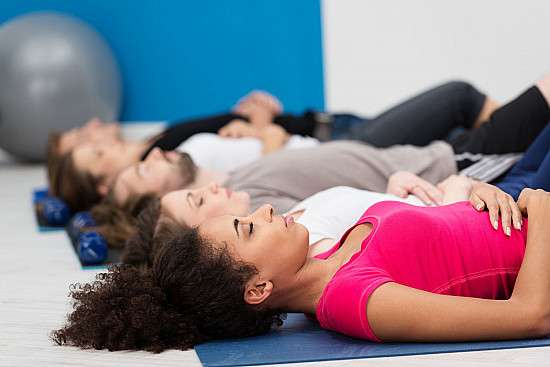This calming breathing technique for stress, anxiety and panic takes just a few minutes and can be done anywhere.
You will get the most benefit if you do it regularly, as part of your daily routine.
You can do it standing up, sitting in a chair that supports your back, or lying on a bed or yoga mat on the floor.
Make yourself as comfortable as you can. If you can, loosen any clothes that restrict your breathing.
If you’re lying down, place your arms a little bit away from your sides, with the palms up. Let your legs be straight, or bend your knees so your feet are flat on the floor.
If you’re sitting, place your arms on the chair arms.
If you’re sitting or standing, place both feet flat on the ground. Whatever position you’re in, place your feet roughly hip-width apart.
- Let your breath flow as deep down into your belly as is comfortable, without forcing it.
- Try breathing in through your nose and out through your mouth.
- Breathe in gently and regularly. Some people find it helpful to count steadily from 1 to 5. You may not be able to reach 5 at first.
- Then let it flow out gently, counting from 1 to 5 again, if you find this helpful.
- Keep doing this for at least 5 minutes.
Take a deep breath in. Now let it out. You may notice a difference in how you feel already. Your breath is a powerful tool to ease stress and make you feel less anxious. Some simple breathing exercises can make a big difference if you make them part of your regular routine.
Before you get started, keep these tips in mind:
- Choose a place to do your breathing exercise. It could be in your bed, on your living room floor, or in a comfortable chair.
- Don’t force it. This can make you feel more stressed.
- Try to do it at the same time once or twice a day.
- Wear comfortable clothes.
Many breathing exercises take only a few minutes. When you have more time, you can do them for 10 minutes or more to get even greater benefits.
Did you know that slowing our breathing helps us calm down, and that taking a few minutes to do breathing exercises can help relax our mind and bodies — making it easier for us to cope with stress and anxiety? It’s actually scientifically proven that breathing not only helps calm us down, but also makes it easier to access and use what we have learned, such as information we have studied for an exam. We also know that continued shallow breathing can actually do the opposite, keeping our bodies in a cycle of stress and affecting everything from our mental to physical health. When we are stressed, we tend to close down in a number of ways and, while this can feel protective, it often deprives us of needed emotional, cognitive and physical resources. It can even make us more likely to get sick.
Here are some simple breathing exercises you can do to relieve stress anywhere and anytime. Try using them daily, whether you are clearly feeling stressed or not. Breathing fully, whether you are stressed or not, is great for your body and mind. It is also easier to use breathing techniques whenever you feel impatient or frustrated (like waiting in line), or in moments when you feel uptight, overwhelmed, stressed, or anxious if you have practiced when you are not stressed.
The Box Breath Technique
This technique is named for the 4-sided approach in which each “side” or step is the same amount of time, as if you were visually creating a box with your breath.
- Exhale all the air from your lungs while counting to four.
- Hold for a count of four, keeping your lungs completely empty.
- Inhale a deep, full breath for a count of four.
- Keep your lungs full for a count of four.
- Do this for at least four rounds and reduce the number of rounds if you start to feel light headed.
For visual learners, this video can act as a helpful guide for the Box Breath technique. Exhale when the flower expands. Hold when the flower is still. Inhale when the flower contracts. Repeat as needed.
4-7-8 Relaxing Breath
Sit or lie down in a comfortable position. Your eyes can be slightly opened or fully closed. Press the tip of your tongue to the roof of your mouth and open your mouth slightly. Exhale until all the air is released from your lungs.
- Close your mouth and inhale through your nose for 4 – 8 counts (you can work up to 8 counts as your lung capacity increases).
- Hold your breath for 7 counts.
- Exhale very slowly for 8 counts.
- Repeat steps 1-3 four times.
Additional Resources and Techniques
If Jewel can do it, so can you. The Grammy-Winning singer walks you through two mindful breathing techniques that she uses in her routine.
The app Headspace is another great tool for breathing on the go. This video offers a one-minute exercise you can do anywhere.
Breathing exercises offer an extremely simple, effective, and convenient way to relieve stress and reverse your stress response, reducing the negative effects of chronic stress. There are definite benefits of breathing exercises. While simple diaphragmic breathing can provide relaxation and stress relief, there are several different types of breathing exercises to try, each with its own twist. Here are several breathing exercises, some of which are commonly recommended, some of which are unique, and all of which can each offer help in managing stress. This is an easy exercise that only takes a few minutes. Here’s how.
Mindful Diaphragmic Breathing
Get into a comfortable position, close your eyes, and start to notice your breath. Before you begin to alter it, pay attention to the pace and depth. Are you taking deep breaths or shallow ones? Are you breathing quickly or slowly? (Becoming aware of your breathing can help you to become more mindful of your body’s response to stress, and can help you to notice when you need to deliberately relax your breathing.)
Counted Breathing
Counting your breaths can be helpful, both for pacing and as a form of meditation. This technique helps with pacing—it enables you to elongate your breath and stretch out your exhales. There are a few ways to do this.
- As you inhale, place your tongue on the roof of your mouth right behind your teeth, then breathe through your nose and slowly count down from five; on the exhale, let the air escape through your mouth and count back up to eight. Then repeat. This helps you to really empty your lungs and relax into each breath.
- A variation of this is known as “4-7-8 breathing,” and is recommended by wellness expert Dr. Andrew Weil. With this option, you inhale for a count of four, wait for a count of seven, and exhale for a count of eight. This allows you to pause between breaths and really slow things down. When you’re first starting out, practice 4-7-8 breathing for four breaths, and then gradually work your way up to eight full breaths.
Set Your Own Pace
Experiment with whatever ratio feels comfortable to you, and see if it helps you to feel relaxed. The act of counting as you breathe still helps you to maintain a steady pace and keep your mind on your breath and the present moment, so it is still more effective than simply breathing regularly and unconsciously.
Visualization Breathing: Inflating the Balloon
Get into a comfortable position, close your eyes, and begin breathing in through your nose and out through your mouth. As you inhale, imagine that your abdomen is inflating with air like a balloon. As you exhale, imagine that the air is escaping the balloon slowly. Remember, you do not have to force the air out; it simply escapes on its own, in its own time. You may want to imagine the balloon as your favorite color, or that you are floating higher in the sky with each breath if this is relaxing for you. Regardless, the “inflating balloon” visualization can help you to breathe deeply from your diaphragm rather than engaging in shallow breathing that can come from stress.
Visualization Breathing: Releasing Your Stress
Get into a comfortable position, close your eyes, and start diaphragmic breathing. As you inhale, imagine that all the stress in your body is coming from your extremities and into your chest. Then, as you exhale, imagine that the stress is leaving your body through your breath and dissipating right in front of you. Slowly, deliberately repeat the process. After several breaths, you should feel your stress begin to subside.
Deep, Cleansing Breath
Sometimes all you need to release stress from your shoulders, back, or the rest of your body is a few big, cleansing breaths. Breathe in deeply through your nose, and take in as much air as you comfortably can. Then release it, and really focus on emptying your lungs. (Many people hold air in their lungs after an exhale, so emptying your lungs on a deep exhale can help you to get more fresh oxygen into them.) Repeat this breathing exercise for a few breaths and release the tension in your back, your shoulders, and anywhere else it tends to reside.
Alternate Nostril Breathing
This breathing exercise variation has been practiced for thousands of years as a form of meditative breathing. As you inhale, place your finger over your right nostril and only breathe through your left. On the exhale, switch nostrils and only breathe through your right. You can breathe at whatever pace is comfortable for you, either a 5-8 ratio, a 4-7-8 ratio or whatever pace feels most relaxing for you (see “counted breathing,” above). Repeat this exercise for up to five minutes.
Explore More Options
There are numerous other ways to practice breathing exercises, but these are some of the most popular and effective. Experiment and see which work best for you.



